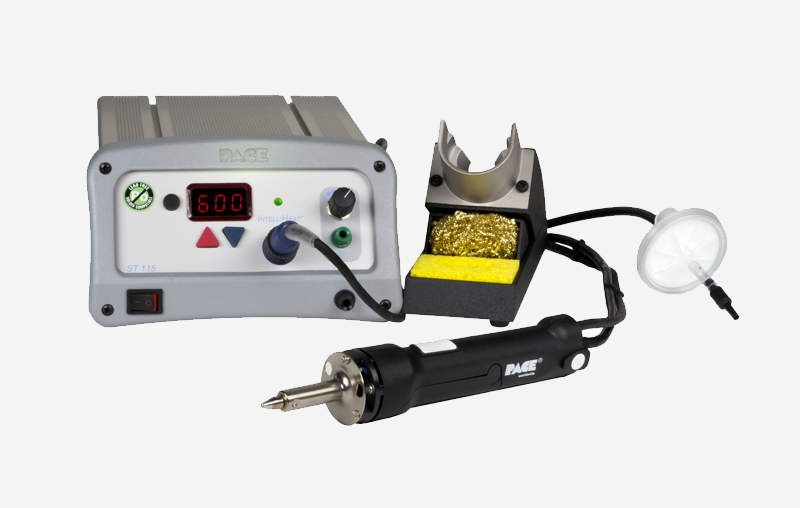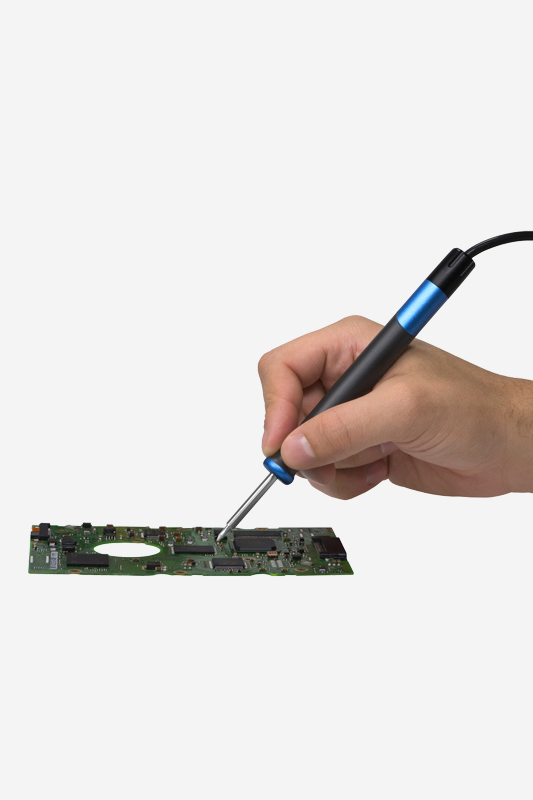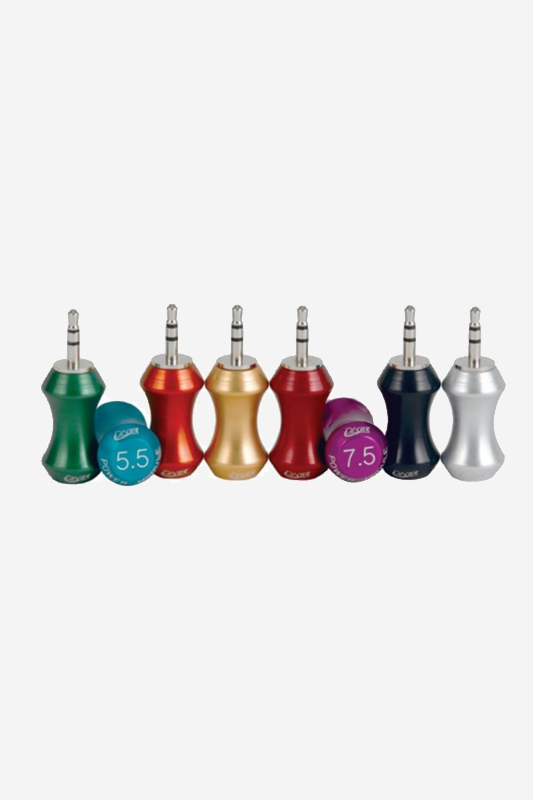In the offer of manufacturers of devices for assembly and disassembly of electronic circuits there are many different types of soldering stations and similar tools, but only some of them allow for fully professional work with lead-free solders.
Probably many electronic engineers were wondering how the need for lead-free solders would affect their daily work. A change in the composition of the solder seemingly small, is associated with serious consequences affecting the soldering process, which as we know is expected to ensure high quality and reliability of the connections created. Lead-free solders usually have higher melting temperatures than the lead-containing alloys used so far. This causes the temperature window in the soldering process to decrease and temperature control must be even more precise.
Since the chemical composition of the solder also necessitates changes in the construction of the tips, the transition to lead-free technology often requires the replacement of existing soldering tools with new ones.
The article provides information on problems related to manual soldering, with the example of soldering stations of the American company Pace, present on the Polish market for a long time. The information can be useful not only for electronics technicians – practitioners, but also, to a large extent, for electronics assembly service providers, electronic services and other companies that want to enter the era of lead-free technology quickly and confidently.
IT WILL BE HERE SOON
Before we discuss the technological problems associated with the use of new types of solder, let’s take a brief look at the legal requirements for their use. In less than a year, from July 1, 2006, Directive 2002/95/EC will come into force in the European Union, prohibiting the use of lead and other hazardous substances in electrical and electronic equipment.
Soon, therefore, also in Poland, it will be prohibited to place on the market products which contain more prohibited substances than the permitted quantities by weight – for lead, this limit is 0.1% of the weight of homogeneous materials used (these are materials which cannot be separated mechanically). Soldering agents used for, among others, hand soldering are also homogeneous materials. This problem concerns both individual components as well as entire electronic systems and covers both distributors of electronic components and equipment as well as manufacturers. One of the effects of the described changes is also the introduction of changes in the offer of manufacturers and distributors of tools for assembly and disassembly of electronic circuits.
PROBLEMS TO BE ADDRESSED
The list of potential problems and issues related to the use of lead-free solders is very extensive. The most important change, compared to lead technology, is the mentioned necessity of soldering with temperatures higher by 30°C to 40°C on average (melting point of the popular alloy of tin, silver and copper is about 220°C). There are, of course, alloys that allow for work with lower temperatures (they usually contain bismuth or zinc), but most often they are more difficult to use and more expensive, making them less popular with manufacturers. However, regardless of the type of solder], the temperature of the process cannot be arbitrarily high – too high a temperature can cause, among other things, too fast evaporation of the flux, damage to the PCB and overheating of the elements themselves. You should also be aware that higher temperature and faster oxidation of lead-free solders is associated with the need to use fluxes with a different chemical composition than before – usually more chemically aggressive and guaranteeing a longer flux activity time in the soldered area.
An important problem is also the poorer covering of the elements connected by new solders, which results in longer soldering time. The solution is to select the appropriate quality flux and take care of the correctness of the temperature profile of soldering – it should be set so that the zone where the solder is liquid is slightly longer than standard. In the case of manual soldering, this can simply consist of taking care to maintain a certain temperature and „slower“ soldering accordingly. But here, too, there is the other side of the coin – if the temperature rises too slowly, the soldered surfaces can oxidise.
Most often the reason for a complete lack of covering is too low a process temperature, resulting from the capabilities of the soldering station. The above mentioned features of lead-free technology contribute to a more frequent occurrence of defects than in the case of working with lead-based solders – in particular, due to premature evaporation of the flux, cold solders may be formed. A typical defect in lead-free technology is also the formation of so-called whiskers – they can lead to short circuits in the system. New solders also make it difficult to control the correctness of the connections – among other things, because of the graininess of the solder itself.
Finally, the use of environmentally friendly technology has a negative impact on the assembly and disassembly tools themselves. This is particularly true for soldering station tips – even for the most expensive ones, where they are not designed for lead-free technology, life expectancy is drastically reduced. Due to the high tin content of the soldering compound, the surface of the tip oxidizes much faster and stops being covered by the solder. One way to combat these phenomena is to use a protective nitrogen atmosphere during soldering, which prevents oxygen from getting into the soldering area, protecting the blade and making it easier to make the correct connection.
SOLDERING STATION – SEEMINGLY SIMPLE DEVICE
The quality of the soldered connections and the future reliability of the assembled devices largely depends on the soldering station used and the consumables.
Also important is the comfort of soldering (in the case of the operator) and the ability to control the process and ensure its repeatability (this applies for example to a technologist in the company). Particularly in the case of industrial applications, the soldering station should, regardless of the soldering technology, allow for continuous and long-lasting work, which is necessary for its physical resistance to high temperatures. Finally, a good soldering station means precise control of soldering process parameters, the possibility of working with different tips and low purchase and operating costs. Too many requirements? Let’s start from the beginning – this time discussing specific devices. As an example, we will use the soldering station HW50 from Pace, which has advanced control functions of the soldering process. This station is controlled by a built-in microprocessor system and provides a high level of temperature stability, suitable for use in lead-free assembly. The operating temperature itself is set by using so-called power modules (described in the next section). The maximum soldering temperature of 455°C is fully sufficient for operation with any type of lead-free solders. When buying a soldering station, it is also worth to pay attention to its functions, such as automatic shutdown or „temperature reversal“, which significantly increases the service life of the tips used. Since the manufacturer offers a wide range of additional equipment for HW50, including several dozen tips and other heads, the size and type of tip used can always be appropriately selected to the dimensions and type of the areas to be soldered, i.e. to their thermal capacity. In the case of lead-free soldering of larger components, the offered tips with an increased heat capacity can also come in handy.
An important factor, which should be particularly noted by repair shops employees and technicians in other companies, is also the time needed to replace the tip. It is the shortest and takes just a few seconds when the tips are pressed in (e.g. in HW stations), and the longest when the tips are mechanically mounted and need to be cooled down before they can be replaced. An interesting fact is that in the case of HW stations, the replacement of the tip does not even require switching off the power supply! The topic of lead-free soldering will be continued in the following parts of the article.


